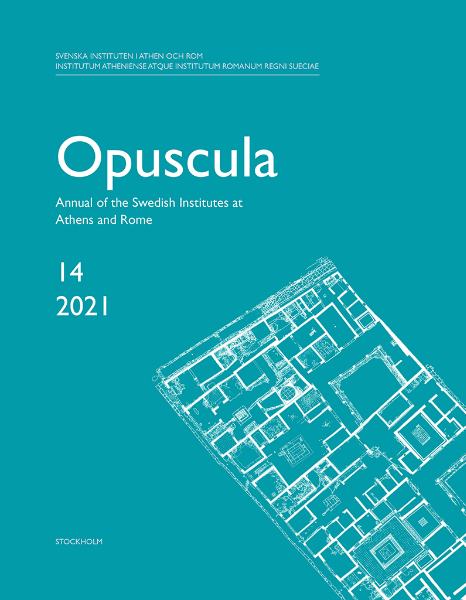
Contents
Žarko Tankosić, Fanis Mavridis, Paschalis Zafeiriadis & Aikaterini Psoma | Gourimadi Archaeological Project. The results from the first excavation season (2018) of a prehistoric site in the Karystia, southern Euboea (pp. 7-26)
Anton Bonnier, Therese Emanuelsson-Paulson, Dimitra Mylona & Arto Penttinen | The Kalaureia Excavation Project. A preliminary report of the work carried out in Area L between 2015 and 2018 (pp. 27-54)
Maria Vaïopoulou, Robin Rönnlund, Fotini Tsiouka, Derek Pitman, Sotiria Dandou, Rich Potter & Johan Klange | Some preliminary notes on the limited 2020 campaign of the Palamas Archaeological Project (PAP) (pp. 55-63)
Alcestis Papadimitriou | An ancient cityscape and its people: A study of ancient Hermione. Introductory remarks on historical sources and visible remains, archaeological research and prospects (pp. 65-76)
Henrik Gerding | The topography of Hermione—A preliminary outline (pp. 77-99)
Jesper Blid, with an appendix by Baukje van den berg | The Temple of Demeter Chthonia at Hermione (pp. 101-134)
Patrik Klingborg | The cisterns of the Bisti promontory at Hermione. With a preliminary description of the Roman aqueduct (pp. 135-155)
Angeliki Kossyva | Life and death in ancient Hermione. Excavations in the necropolis (pp. 157-167)
Jenny Wallensten | The key to Hermione? Notes on an inscribed monument (pp. 169-180)
Anne-Marie Leander Touati, Thomas Staub & Renée Forsell | From 2D and 3D documentation to 4D interpretation. Building archaeological conclusions and workflow strategies gained by remote study of Insula V 1, Pompeii (pp. 181-226)
Vassos Karageorghis & Efstathios Raptou, with appendices by Alexander Donald, Gisèle Clerc & Anna Spyrou | Palaepaphos-Teratsoudhia Tomb 288 (c. 1650 BC–c. 1200 BC) (pp. 227-280)
Sabine Fourrier & Anna Georgiadou, in collaboration with Bérénice Chamel, Nathalia Denninger, Armelle Gardeisen, Katerina Papayanni & Tatiana Theodoropoulou | The death of infants in Early Iron Age Cyprus. A jar burial from Kition-Bamboula (pp. 281-304)
Nota Kourou | Ancestral and chthonic cults at Tenos (pp. 305-329)
Jenifer Neils | Bulls and rams. The sacrifice to Erechtheus (pp. 331-339)
J.Z. Van Rookhuijzen | The Turkish harem in the Karyatid Temple and antagonistic narratives on the Athenian Acropolis (pp. 341-362)
Chrysanthos Kanellopoulos & Elena Partida | The Temple of Zeus at Lebadea. The architecture and the semantics of a colossus (pp. 363-400)
Lisa Hagelin | Commending a freedman. Virtues and masculinities in the recommendation letters of Cicero and Pliny the Younger (pp. 401-418)
Julia Habetzeder | The Invitation to the Dance. An intertextual reassessment (pp. 419-463)
Book reviews (pp. 465-478)
Bibliographical information
Opuscula. Annual of the Swedish Institutes at Athens and Rome (OpAthRom) 14, Stockholm 2021. ISSN: 2000-0898. ISBN: 978-91-977799-3-7. Softcover, 478 pages. https://doi.org/10.30549/opathrom-14
Opuscula. Annual of the Swedish Institutes at Athens and Rome is published annually by the Swedish Institutes at Athens and Rome. First issued in 2008 (no. 1), Opuscula replaces the annuals Opuscula Atheniensia and Opuscula Romana published by the Swedish Institute at Athens and the Swedish Institute in Rome respectively.
Opuscula is a refereed periodical, published in colour and available in print and in electronic format six months after publication.
The annual contains articles within Classical Archaeology, Ancient History, Art, Architecture and Philology, as well as book reviews within these subjects. Reports of fieldwork carried out under the supervision of the Institutes at Athens and Rome are regularly reported on in the Opuscula.
The annual welcomes contributions pertaining to the ancient Mediterranean world (prehistory to Late Antiquity) and the Classical tradition and drawing on archaeological, historical and philological studies; contributions dealing with later periods in the areas, especially in the fields of art, architecture, history and cultural heritage are also welcome.
The bibliographical abbreviation for Opuscula is OpAthRom.
Deadline for submissions to Opuscula is 1 November each year. All authors should consult ECSI Guides for Contributors (see Author resources) before submitting their manuscripts. Manuscript are submitted to the Secretary of the Editorial board (see Contact).
http://ecsi.bokorder.se/Opuscula.aspx

Newly published: Annual of the Swedish Institutes at Athens and Rome, vol. 14, 2021.
Printed: 2024-11-01
From the web page: Swedish Institute at Athens
https://www.sia.gr/en/sx_PrintPage.php?export=html&tid=582?export=html&tid=582